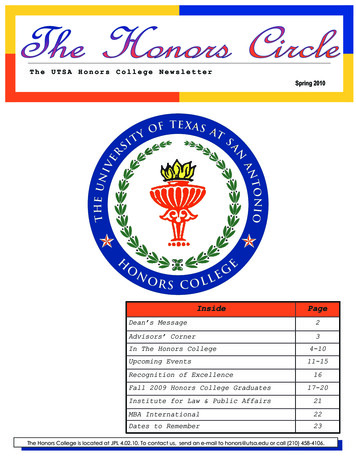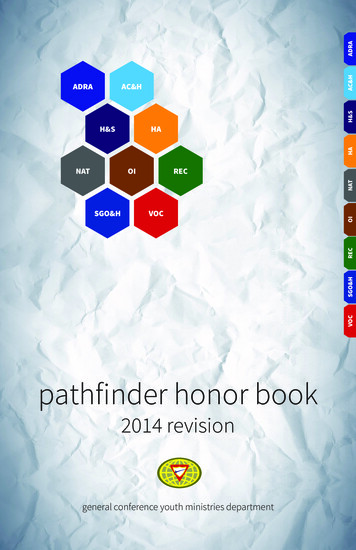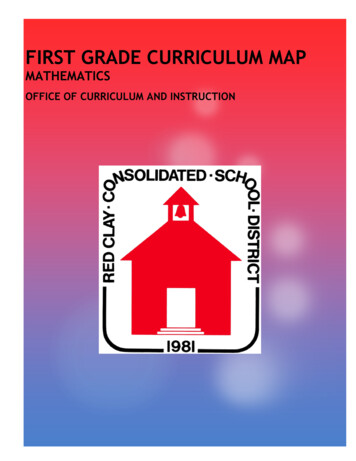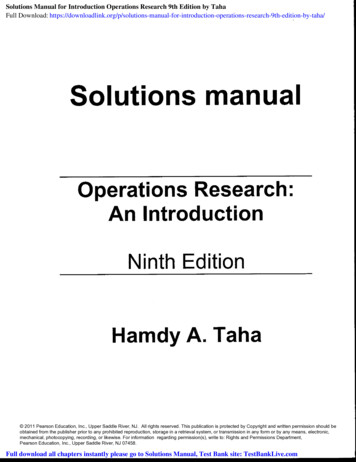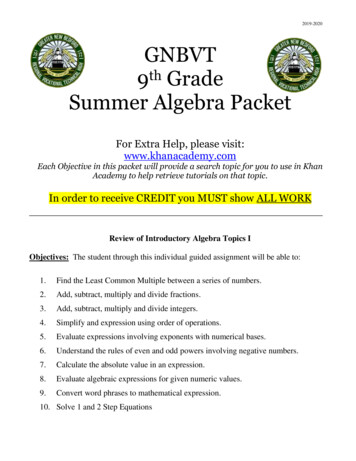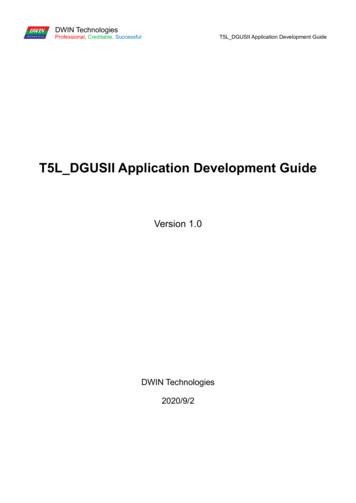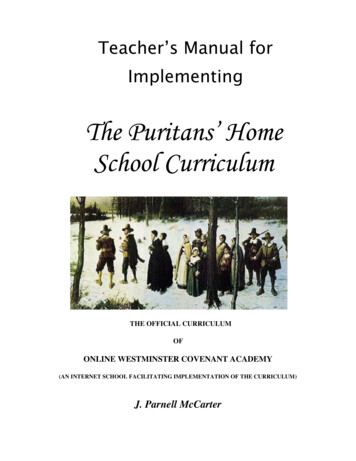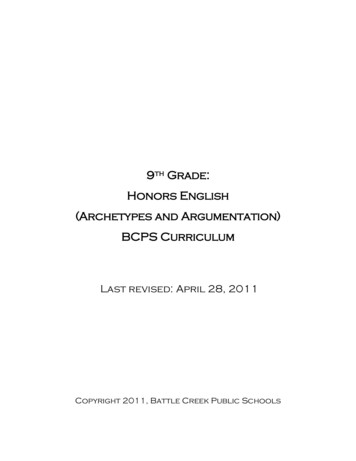
Transcription
9th Grade:Honors English(Archetypes and Argumentation)BCPS CurriculumLast revised: April 28, 2011Copyright 2011, Battle Creek Public Schools
TABLE OF CONTENTSIntroduction to BCPS Language DocumentsCourse PhilosophyFocus QuestionsCourse OverviewNational Common Core Standards Application Chart.Suggested Pacing GuideUnit by Unit breaks downEvidence of Student Learning Chartpg. 2pg. 3pg. 5pg. 6pgpg.pg.pg.Introduction to BCPS-Language ArtsCurriculum DocumentsThis is living document – one that has evolved over time and will continue to change andgrow in the future. If you are teaching the class for which this curriculum has been written,then you should be aware that you are required to cover the outcomes listed in thisdocument. To help you with this, we have included suggested texts, activities, and even pacingguides that support these outcomes. Teachers have the freedom to change or adapt activitiesand pacing to fit their own class’ needs. Teachers may add or change some of the texts for acourse, although any novel/textbook changes must be approved by the Board of Education.We have carefully written these outcomes for what we expect to have to teach thisparticular grade level. These outcomes are written with the expectation that these studentsalready have covered the outcomes from previous years. For example, unity within a piece ofwriting is important, but it is not one of the outcomes for senior English because we assumethat it has already been dealt with in prior classes. We hope that this will save students fromhaving to hear the same material, year after year. Nevertheless, if a teacher notes that a classneeds to go back and review some skills from previous years, then the teacher should do so.Most of our assumptions of what this grade level should already be able to do areincorporated into the sample rubrics for the writing assignments. Another source for findingout what the previous grade did is, of course, that grade’s curriculum document.A last note on the outcomes: After each outcome is a code linking it to the strand, standard,and content expectation.2 Page
Philosophy for 9th Grade Honors Curriculum9th Grade Honors English is a course designed to expand on the knowledge acquired inJunior High as well as introduce the major components of the Advanced Placement Curriculum:Literary Archetypes and Argumentation. As a department, we assume that students come inwith the following literacy capacity:Reading a variety of genres and distinguishing the general forms and featuresArticulating personal reactions to texts through writing, reflection, anddiscussionWriting in a variety of genres for different purposesUnderstanding the basic grammatical structures and how grammar may be usedto affect voice and meaningWith this background, the primary goal of 9th Grade Honors English is to create alearning environment where students can take ownership of their own learning process andbecome aware of their strengths and weaknesses as readers, writers, and participants in oraldiscussion all the while processing pieces of classical literature as well as informational texts.While the general outcomes of this course are aligned with the National Common CoreStandards, the general outcomes of the Honors Class are predicated on Rosenblatt’s theory ofreader response and are therefore constructed of the following:Students will connects the text to the current world issues that are relevant totheir own worldsStudent will develop and retain a love of literature, reading, and writingStudents will connect themselves to the emotional heart of the textStudents will read and analyze poetry, prose, and dramaStudents will develop a solid background in classic literature as well as qualitymodern literatureStudents will prepare themselves for the expectations of their junior and seniorAdvanced Placement courseworkStudents will write and support arguments based on fiction and non-fictionStudents will develop their use of grammar and sentence structureStudents will analyze how voice is constructed and refine their ownStudents will express themselves creatively through artistic choicesStudents will build the work ethic and staminaStudents in 9th Grade Honors English will be exposed to a variety of literary pieces andgenres such as drama, short stories, novels, poetry and expository texts. Through the study ofthese texts, they will engage in metacognitive activities: considering what they do to interpret a3 Page
text based on their unique prior knowledge, and how they construct an interpretation whenmeaning breaks down. In other words, students will be armed to fight difficult texts—in highschool, college, and life—with an arsenal of literacy strategies. They will also analyze texts forstylistic devices authors use to engage their audience. This will serve two purposes: one, thatthey have the tools necessary to assist them when searching for messages inferred in the text;two, that they can consider their own style and the ways their stylistic choices can engage theiraudience. Students will practice writing for various purposes (specifically through creative andexpository modes) and implement tools in their own craft. Ultimately, student writing exercisewill culminate in literary analysis paper (end of semester one), a personal narrative (opening ofsemester two), and a research paper (end of semester two). Finally, students will reflect ontheir growth as a reader and writer and articulate the purpose behind the strategies they use toheighten their literacy awareness; this reflection will come in the form of discussion andwriting, where students will be encouraged to overcome fears of peer collaboration and beginto voice their thoughts clearly and honestly.Overall, these units are designed to provide students with tools to critically engage inthe world through reading, writing, and dialogue. These skills will prepare students with thefoundation they need to be successful throughout their high school career and begin them onthe path toward becoming critical, historically and culturally informed citizens.4 Page
9th Grade Honors Focus Questions(*Derived from state of Michigan Recommendations)Semester OneUnit 1What are literary archetypes? Why are they important?Where do I stand in relation to these archetypes?Unit 2How do archetypes function in society?How do I build networks of people to support me?*How am I a reflection of my relationships?*How do my relationships within and across groups affect others?*Unit 3How do my skills and talents help to define me? *How do I relate to my family, my community and society?*What influence do class, religion, language, and culture have on myrelationships and my decisions?*Semester TwoUnit 4What is voice in writing? How is it constructed?*What does my own voice sound like?*Unit 5What is social criticism?How does media shape my view of the world?How do I see my beliefs reflected in our government?*Unit 6What are the primary principles of argumentation?How is literature used to make arguments?What is my responsibility to society?*What can I contribute as an individual?*Unit 7How do archetypes and argumentation work together?What change should be made in society? Why? How?5 Page
Honors 9th Grade Curriculum Semester One OverviewUnit 1: A Quest is Never a QuestThe Odyssey by HomerSiddhartha by Herman Hesse“Odysseus” by W.S. MerwinExcerpts from The Lost Tales of theOdyssey“Where I am From” by George EllaLyonVocabulary Lists 1-4: ArchetypesHow do archetypes and theirvariances affect the meaning oftext?Unit 2: Driving ForcesRomeo and Juliet by WilliamShakespeareVocabulary Lists 5-8: Archetypes,Poetry, elements of literatureAssorted Sonnets includingShakespeare’s “Sonnet 116” andFrost’s “The Road Not Taken”Pablo Neruda’s “Ode to BrokenThings”How do archetypes and theirvariances affect the meaning of text?Unit 3:Lord of the Flies by William GoldingLong Way Home by Ishmael Beah“The Most Dangerous Game” byRichard ConnellVocabulary Lists 9-10: elements ofliteratureHow do archetypes and theirvariances the affect meaning oftext?Thematic Connection toStudent/Modern LifeThe War at Home: The Effects ofWar on FamiliesBad Parenting 101: Recipe for aTragedyRequired Assessments andWritingsCreative Writing: I am from PoemCreative Writing: Character Poem 2 draftsReflection on character poemLiterary Analysis: EvolvingArchetypesReflection on Literary AnalysisVideo Games and Playing at Death“Pack” PsychologyChild Soldiers in Africa and AsiaCreative Writing: Write a scene thatparodies Lord of the Flies, or Romeoand Juliet, or OdysseyReflection on ParodyLiterary Analysis: Allegory and SymbolReflection on Literary AnalysisFinal Exam: Redrafted Essay ofstudent choice of testsGrammar/Style FocusBasic Structures:o Thesiso Topic sentenceso Tie-back sentenceso TransitionsLiterary Deviceso Parallel structureAnchor Texts – Literature andArchetype FocusCreative Writing: Sonnets or OdesReflection on Sonnet or OdeLiterary Analysis: MotifsReflection on Literary AnalysisPoetry Elementso Rhymeo Personificationo Enjambmento End-stoppedo Caesurao Heroic coupletVerisimilitudeAmbiguitySubtextParodyGrammar Basics:o Subject/ Verb agreemento Adjective Clause6 Page
o Anaphorao Assonanceo Consonanceo Alliterationo Simileo Metaphoro allusionGrammar Basics:o Iambic pentametero Volta/turnSentences:o Main clauseo Subordinate clauseo phraseo Simpleo Compoundo Complexo Compound complexoooAdverb ClauseNoun ClauseParticiples and participialphrasesoPrepositional Phraseso Appositiveso Absoluteso Gerundso Infinitives7 Page
Honors 9th Grade Curriculum Overview Semester TwoUnit 1The Catcher in the Rye byJ.D. SalingerWuthering Heights by EmliyBronteVocabularylists 1-2How do archetypes andtheir variances affect themeaning of texts?Unit 2Animal Farm by George Orwell“Boy with his Hair Cut Short”by Rukeyser“Fort Robinson” by KooserExcerpts from Ginsberg’s“Howl”Vocabularylists 3-4How do archetypes and theirvariances affect the meaningof texts?Unit 3A Lesson Before Dying byErnest GainesFences by August WilsonVocabularyList 5How do archetypes and theirvariances affect the meaningof texts?Unit 4The Adventures ofHuckleberry Finn by MarkTwainOnce Upon a River by BonnieJo CampbellHow do archetypes andtheir variances affect themeaning of texts?ThematicConnection toStudent/ModernLifeNot So Crazy: Depression,Anti-Social SocietyDisorder, Post TraumaticStress DisorderSpin, Spin, Spin: PoliticalManipulation and the MediaThe Blood of Patriots: CivilDisobedienceHarsh Words: Censorship inthe United StatesHomeless Children in theUnited States and AbroadRequiredAssessments andWritingsCreative Writing:o Personal NarrativeLiterary AnalysisReflection on LiteraryAnalysisGrammar/StyleFocusStyle and Voiceo Syntaxo Dictiono ToneWe Don’t Need NoEducation?: TeenagersPerspectives on EducationEye for an Eye?: CapitalPunishment in the UnitedStatesCreative Writing: Write anewspaper editorial/blogabout the conviction ofJefferson (utilizing rhetoricaldevices) – 2 draftsReflection on editorialLiterary AnalysisReflection on LiteraryAnalysisRhetorical Devices List II:Identify and ExperimentAnchor Texts –Literature andArchetype FocusCreative Writing: Poems ofSocial ProtestLiterary AnalysisReflection on Literary AnalysisImitations of “Howl” or “FortRobinson”Propaganda and LogicalFallaciesAppeal Typeso Ethos, pathos, logosFinal Exam : PersuasiveSpeech utilizing rhetoricaldevices – 3 draftsFinal Exam: Literary AnalysisEssayFinal Exam: PropagandaAnalysis of Bowling forColumbineRhetorical Devices List III:Identify and Experiment8 Page
o Detailo Colloquialismso Idiosyncrasieso Sarcasmo Infero ImplyGrammarPunctuation:o Commaso Dasheso Parentheseso Quotation MarksUses of Rhetorical Deviceso Persuadeo Entertaino Informo ExpressRhetorical Devices List I:identify and experiment9 Page
National Common Core 9-10 StandardsX Addressed, F Special FocusREADINGLITERATUREUnit 1Unit 2Unit 3Unit 4Unit 5Unit 6Unit 7XXXXXXXXXXXXXXXFXXXFXXXXFXXXXFXXXXXKey Ideas and DetailsRL.9-10.1. Cite strong andthorough textual evidenceto support analysis of whatthe text says explicitly aswell as inferences drawnfrom the text.RL.9-10.2. Determine atheme or central idea of atext and analyze in detailits development over thecourse of the text,including how it emergesand is shaped and refinedby specific details; providean objective summary ofthe text.RL.9-10.3. Analyze howcomplex characters (e.g.,those with multiple orconflicting motivations)develop over the course ofa text, interact with othercharacters, and advancethe plot or develop thetheme.Craft and StructureRL.9-10.4. Determine themeaning of words andphrases as they are used inthe text, includingfigurative and connotativemeanings; analyze thecumulative impact ofspecific word choices onmeaning and tone (e.g.,how the language evokes asense of time and place;how it sets a formal orinformal tone).RL.9-10.5. Analyze how anauthor’s choices concerninghow to structure a text,order events within it (e.g.,10 P a g e
parallel plots), andmanipulate time (e.g.,pacing, flashbacks) createsuch effects as mystery,tension, or surprise.RL.9-10.6. Analyze aparticular point of view orcultural experiencereflected in a work ofliterature from outside theUnited States, drawing ona wide reading of worldliterature.FXFXXXXIntegration of Knowledge and IdeasRL.9-10.7. Analyze therepresentation of a subjector a key scene in twodifferent artistic mediums,including what isemphasized or absent ineach treatment (e.g.,Auden’s “Musée des BeauxArts” and Breughel’sLandscape with the Fall ofIcarus).RL.9-10.8. (Not applicableto literature)RL.9-10.9. Analyze how anauthor draws on andtransforms source materialin a specific work (e.g., howShakespeare treats atheme or topic from Ovidor the Bible or how a laterauthor draws on a play byShakespeare).FFXFXXFXXXXXXXRange of Reading and Level of Text ComplexityRL.9-10.10. By the end ofgrade 9, read andcomprehend literature,including stories, dramas,and poems, in the grades9–10 text complexity bandproficiently, withscaffolding as needed atthe high end of the range.XX11 P a g e
READING INFORMATIONALTEXTUnit 1Unit 2Unit 3Unit 4Unit 5Unit 6Unit FFFFFFKey Ideas and DetailsRI.9-10.1. Cite strong and thoroughtextual evidence to support analysis ofwhat the text says explicitly as well asinferences drawn from the text.RI.9-10.2. Determine a central idea of atext and analyze its development over thecourse of the text, including how itemerges and is shaped and refined byspecific details; provide an objectivesummary of the text.RI.9-10.3. Analyze how the author unfoldsan analysis or series of ideas or events,including the order in which the pointsare made, how they are introduced anddeveloped, and the connections that aredrawn between them.Craft and StructureRI.9-10.4. Determine the meaning ofwords and phrases as they are used in atext, including figurative, connotative,and technical meanings; analyze thecumulative impact of specific word choiceson meaning and tone (e.g., how thelanguage of a court opinion differs fromthat of a newspaper).RI.9-10.5. Analyze in detail how anauthor’s ideas or claims are developedand refined by particular sentences,paragraphs, or larger portions of a text(e.g., a section or chapter).RI.9-10.6. Determine an author’s point ofview or purpose in a text and analyze howan author uses rhetoric to advance thatpoint of view or purpose.Integration of Knowledge and IdeasRI.9-10.6. Determine an author’s point ofview or purpose in a text and analyze howan author uses rhetoric to advance thatpoint of view or purpose.RI.9-10.8. Delineate and evaluate theargument and specific claims in a text,assessing whether the reasoning is validand the evidence is relevant andsufficient; identify false statements andfallacious reasoning.RI.9-10.9. Analyze seminal U.S.documents of historical and literarysignificance (e.g., Washington’s FarewellAddress, the Gettysburg Address,12 P a g e
READING INFORMATIONALTEXTUnit 1Unit 2Unit 3Unit 4Unit 5Unit 6Unit 7XXXXXXXUnit 1Unit 2Unit 3Unit 4Unit 5Unit 6Unit 7XXXXXFFXXXXXFFRoosevelt’s Four Freedoms speech, King’s“Letter from Birmingham Jail”), includinghow they address related themes andconcepts.Range of Reading and Level of Text ComplexityRI.9-10.10. By the end of grade 9, readand comprehend literary nonfiction in thegrades 9–10 text complexity bandproficiently, with scaffolding as needed atthe high end of the range.WRITINGText Types and Purposes1W.9-10.1. Write arguments to supportclaims in an analysis of substantive topicsor texts, using valid reasoning andrelevant and sufficient evidence.Introduce precise claim(s), distinguishthe claim(s) from alternate oropposing claims, and create anorganization that establishes clearrelationships among claim(s),counterclaims, reasons, and evidence.Develop claim(s) and counterclaimsfairly, supplying evidence for eachwhile pointing out the strengths andlimitations of both in a manner thatanticipates the audience’s knowledgelevel and concerns.Use words, phrases, and clauses tolink the major sections of the text,create cohesion, and clarify therelationships between claim(s) andreasons, between reasons andevidence, and between claim(s) andcounterclaims.Establish and maintain a formal styleand objective tone while attending tothe norms and conventions of thediscipline in which they are writing.Provide a concluding statement orsection that follows from and supportsthe argument presented.W.9-10.2. Write informative/explanatorytexts to examine and convey complexideas, concepts, and information clearlyand accurately through the effectiveselection, organization, and analysis ofcontent.13 P a g e
WRITINGUnit 1Unit 2Unit 3Unit 4Unit 5Unit 6Unit 7XXFFFXXIntroduce a topic; organize complexideas, concepts, and information tomake important connections anddistinctions; include formatting (e.g.,headings), graphics (e.g., figures,tables), and multimedia when usefulto aiding comprehension.Develop the topic with well-chosen,relevant, and sufficient facts,extended definitions, concrete details,quotations, or other information andexamples appropriate to theaudience’s knowledge of the topic.Use appropriate and variedtransitions to link the major sectionsof the text, create cohesion, and clarifythe relationships among complexideas and concepts.Use precise language and domainspecific vocabulary to manage thecomplexity of the topic.Establish and maintain a formal styleand objective tone while attending tothe norms and conventions of thediscipline in which they are writing.Provide a concluding statement orsection that follows from and supportsthe information or explanationpresented (e.g., articulatingimplications or the significance of thetopic).W.9-10.3. Write narratives to develop realor imagined experiences or events usingeffective technique, well-chosen details,and well-structured event sequences.Engage and orient the reader bysetting out a problem, situation, orobservation, establishing one ormultiple point(s) of view, andintroducing a narrator and/orcharacters; create a smoothprogression of experiences or events.Use narrative techniques, such asdialogue, pacing, description,reflection, and multiple plot lines, todevelop experiences, events, and/orcharacters.Use a variety of techniques tosequence events so that they build onone another to create a coherentwhole.14 P a g e
WRITINGUnit 1Unit 2XXXXUnit 3Unit 4Unit 5Unit 6Unit 7XXXXXXXXXXXXXFFXXFFXXUse precise words and phrases, tellingdetails, and sensory language toconvey a vivid picture of theexperiences, events, setting, and/orcharacters.Provide a conclusion that follows fromand reflects on what is experienced,observed, or resolved over the courseof the narrative.Production and Distribution of WritingW.9-10.4. Produce clear and coherentwriting in which the development,organization, and style are appropriate totask, purpose, and audience. (Gradespecific expectations for writing types aredefined in standards 1–3 above.)W.9-10.5. Develop and strengthen writingas needed by planning, revising, editing,rewriting, or trying a new approach,focusing on addressing what is mostsignificant for a specific purpose andaudience.W.9-10.6. Use technology, including theInternet, to produce, publish, and updateindividual or shared writing products,taking advantage of technology’s capacityto link to other information and to displayinformation flexibly and dynamically.Research to Build and Present KnowledgeW.9-10.7. Conduct short as well as moresustained research projects to answer aquestion (including a self-generatedquestion) or solve a problem; narrow orbroaden the inquiry when appropriate;synthesize multiple sources on the subject,demonstrating understanding of thesubject under investigation.W.9-10.8. Gather relevant informationfrom multiple authoritative print anddigital sources, using advanced searcheseffectively; assess the usefulness of eachsource in answering the research question;integrate information into the textselectively to maintain the flow of ideas,avoiding plagiarism and following astandard format for citation.W.9-10.9. Draw evidence from literary orinformational texts to support analysis,reflection, and research.Apply grades 9–10 Reading standardsto literature (e.g., “Analyze how anauthor draws on and transforms sourcematerial in a specific work [e.g., howXXXXX15 P a g e
WRITINGUnit 1Unit 2Unit 3Unit 4Unit 5Unit 6Unit 7XXXXXXXShakespeare treats a theme or topicfrom Ovid or the Bible or how a laterauthor draws on a play byShakespeare]”).Apply grades 9–10 Reading standardsto literary nonfiction (e.g., “Delineateand evaluate the argument and specificclaims in a text, assessing whether thereasoning is valid and the evidence isrelevant and sufficient; identify falsestatements and fallacious reasoning”).Range of WritingW.9-10.10. Write routinely over extendedtime frames (time for research, reflection,and revision) and shorter time frames (asingle sitting or a day or two) for a range oftasks, purposes, and audiences.16 P a g e
SPEAKING & LISTENINGUnit 1Unit 2Unit 3Unit 4Unit 5Unit 6Unit 7XXXXXXXXXXXXFFXXXXXFFXXXXXFFComprehension and CollaborationSL.9-10.1. Initiate and participateeffectively in a range of collaborativediscussions (one-on-one, in groups, andteacher-led) with diverse partners ongrades 9–10 topics, texts, and issues,building on others’ ideas and expressingtheir own clearly and persuasively.Come to discussions prepared, havingread and researched material understudy; explicitly draw on thatpreparation by referring to evidencefrom texts and other research on thetopic or issue to stimulate athoughtful, well-reasoned exchange ofideas.Work with peers to set rules forcollegial discussions and decisionmaking (e.g., informal consensus,taking votes on key issues,presentation of alternate views), cleargoals and deadlines, and individualroles as needed.Propel conversations by posing andresponding to questions that relatethe current discussion to broaderthemes or larger ideas; activelyincorporate others into the discussion;and clarify, verify, or challenge ideasand conclusions.Respond thoughtfully to diverseperspectives, summarize points ofagreement and disagreement, and,when warranted, qualify or justifytheir own views and understandingand make new connections in light ofthe evidence and reasoning presented.SL.9-10.2. Integrate multiple sources ofinformation presented in diverse media orformats (e.g., visually, quantitatively,orally) evaluating the credibility andaccuracy of each source.SL.9-10.3. Evaluate a speaker’s point ofview, reasoning, and use of evidence andrhetoric, identifying any fallaciousreasoning or exaggerated or distortedevidence.Presentation of Knowledge and IdeasSL.9-10.4. Present information, findings,and supporting evidence clearly,17 P a g e
SPEAKING & LISTENINGconcisely, and logically such that listenerscan follow the line of reasoning and theorganization, development, substance,and style are appropriate to purpose,audience, and task.SL.9-10.5. Make strategic use of digitalmedia (e.g., textual, graphical, audio,visual, and interactive elements) inpresentations to enhance understandingof findings, reasoning, and evidence andto add interest.SL.9-10.6. Adapt speech to a variety ofcontexts and tasks, demonstratingcommand of formal English whenindicated or appropriate.LANGUAGEConventions of Standard EnglishL.9-10.1. Demonstrate command ofthe conventions of standard Englishgrammar and usage when writing orspeaking.Use parallel structure.Use various types of phrases(noun, verb, adjectival, adverbial,participial, prepositional, absolute)and clauses (independent,dependent; noun, relative,adverbial) to convey specificmeanings and add variety andinterest to writing orpresentations.L.9-10.2. Demonstrate command ofthe conventions of standard Englishcapitalization, punctuation, andspelling when writing.Unit 1Unit 2Unit 3Unit 4Unit 5Unit 6Unit 7XXXXXFFXXXFXXXUnit 1Unit 2Unit 3Unit 4Unit 5Unit 6Unit 7FFFFFFFFFFFFFFUse a semicolon (and perhaps aconjunctive adverb) to link two ormore closely related independentclauses.Use a colon to introduce a list orquotation.Spell correctly.Knowledge of Language18 P a g e
LANGUAGEUnit 1Unit 2Unit 3L.9-10.3. Apply knowledge oflanguage to understand how languagefunctions in different contexts, tomake effective choices for meaning orstyle, and to comprehend more fullywhen reading or listening.Write and edit work so that itconforms to the guidelines in astyle manual (e.g., MLAHandbook, Turabian’s Manual forWriters) appropriate for thediscipline and writing type.Vocabulary Acquisition and UseL.9-10.4. Determine or clarify themeaning of unknown and multiplemeaning words and phrases based ongrades 9–10 reading and content,choosing flexibly from a range ofstrategies.Unit 4Unit 5Unit 6Unit 7XXXXXXXXXXXXXXXXXXUse context (e.g., the overallmeaning of a sentence, paragraph,or text; a word’s position orfunction in a sentence) as a clue tothe meaning of a word or phrase.Identify and correctly use patternsof word changes that indicatedifferent meanings or parts ofspeech (e.g., analyze, analysis,analytical; advocate, advocacy).Consult general and specializedreference materials (e.g.,dictionaries, glossaries,thesauruses), both print anddigital, to find the pronunciation ofa word or determine or clarify itsprecise meaning, its part ofspeech, or its etymology.Verify the preliminarydetermination of the meaning of aword or phrase (e.g., by checkingthe inferred meaning in context orin a dictionary).L.9-10.5. Demonstrate understanding19 P a g e
LANGUAGEUnit 1Unit 2Unit 3Unit 4Unit 5Unit 6Unit 7XXXXXXXof figurative language, wordrelationships, and nuances in wordmeanings.Interpret figures of speech (e.g.,euphemism, oxymoron) in contextand analyze their role in the text.Analyze nuances in the meaning ofwords with similar denotations.L.9-10.6. Acquire and use accuratelygeneral academic and domain-specificwords and phrases, sufficient forreading, writing, speaking, andlistening at the college and careerreadiness level; demonstrateindependence in gathering vocabularyknowledge when considering a wordor phrase important to comprehensionor expression.20 P a g e
A Word on Vocabulary:While memorization of these items is helpful, moreattention should be paid to application of them (I.E. howShakespeare manipulates archetypes to help construct meaning,or how a student can utilize a rhetorical device effectively intheir own writing.) The vocabulary exists to establish a commonterminology to facilitate both analysis and writing.21 P a g e
Honors Nine Master Vocab ListHonors 9: Semester I: List I: Situational Archetypes and Characters1. Archetype – n. an original model on which other, similar things are patterned2. The Quest – What the Hero must accomplish in order to bring fertility back tothe wasteland, usually a search for some talisman, which will restore peace,order, and normalcy to a troubled land.3. The Task – The nearly superhuman feat(s) the Hero must perform in order toaccomplish his quest.4. The Journey – The journey sends the Hero in search of some truth that willhelp save his kingdom.5. The Initiation – The adolescent comes into his maturity with new awarenessand problems.6. The Ritual – The actual ceremonies the Initiate experiences that will mark hisrite of passage into another state. A clear sign of the character's role in hissociety7. The Fall – The descent from a higher to a lower state of being usually as apunishment for transgression. It also involves the loss of innocence.8. Death and Rebirth – The most common of all situational archetypes, this motifgrows out of a parallel between the cycle of nature and the cycle of life. Thusmorning and springtime represent birth, youth, or rebirth, while evening andwinter suggest old age or death.9. Battle Between Good and Evil - Obviously, a battle between two primal forces.Mankind shows eternal optimism in the continual portrayal of good triumphingover evil despite great odds.10. The Unhealable Wound - Either a physical or psychological wound thatcannot be fully healed. The wound symbolizes a loss of innocence.11. Odyssey- n. A long adventurous voyage; an intellectual or spiritual quest,derived from the story of Odysseus’s (king of ancient Ithaka and a one of theGreek leaders in the Trojan War) journey home12. Muse – v. to be absorbed in thoughtn. a guiding or inspiring spirit n. one of Zeus’s daughter who presidesover the arts and sciences13. Citadel – n. a fortress14. Nymph – n. a beautiful girln. a minor mythological deity often connected to nature and representedas a beautiful young woman15. Suitor – n. a man who is courting a woman; one who is seeking something –usually through a legal process or romance16. Zeus – n. ruler of the Greek gods, father of other gods and mortals17. Athena (Athene) – n. Greek goddess of wisdom and warfare18. Olympus – n. Greek mountain range; Mount O
Apr 28, 2011 · Philosophy for 9th Grade Honors Curriculum 9th Grade Honors English is a course designed to expand on the knowledge acquired in Junior High as well as introduce the major components of the Advanced Placement Curriculum: Literary Archetypes and Argumentation. As a department, we a
